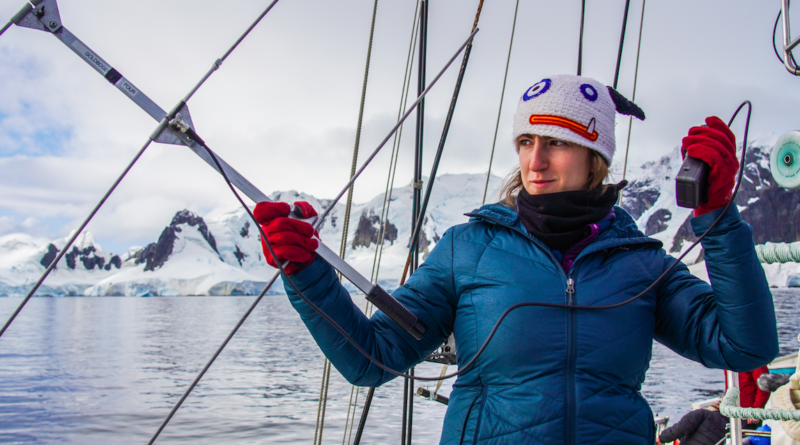INTERVIEW: New PBS series checks in on the health of this ‘Dynamic Planet’
Photo: Dynamic Planet’s inaugural episode, “Ice,” features the scientific research of Shirel Kahane-Rapport. Photo courtesy of PBS / Provided by press site with permission.
Dynamic Planet, a new four-part PBS series, premieres Wednesday, June 19, at 8 p.m. with an episode ominously titled “Ice.” On the show, explorers and scientists head around the globe to see how the planet is surviving and adapting (or not), in light of the increased stresses from climate change. On the first episode, the cameras follow David Cade and Shirel Kahane-Rapport, researchers who headed to western Antarctica to tag and study humpback whales. This part of the world is known as an indicator location, meaning the health of this ecosystem can “indicate” how the rest of the planet is faring.
Other episodes of Dynamic Planet will focus on “Fire” (June 26), “Water” (July 3) and “Earth” (July 10). To better understand the humpback whale research that is the cornerstone of the inaugural episode, Hollywood Soapbox recently talked with Kahane-Rapport, who is now an assistant professor at Old Dominion University in Norfolk, Virginia. “Prior to Old Dominion University, she was a postdoctoral scholar in Dr. Misty Paig-Tran’s lab at California State University, Fullerton,” according to her official biography. “She completed her PhD at the Hopkins Marine Station, Stanford University, with Dr. Jeremy Goldbogen. She has an undergraduate degree from the University of Guelph, in Ontario, Canada, where she is from originally.”
Here’s what she had to say …
On how she became involved in humpback whale research …
“I was in this project when I was in graduate school, and I was a PhD student … at Hopkins Marine Station in Stanford University. … I was a grad student there. I was working on studying how whales move, how they eat, how they filter, and we used tags for that. And the previous year I had gone down to the Antarctic, and it was a really successful season. So when the opportunity came to the lab again, I was chosen to go down. I was included in the decision, and I went down there. And it was amazing.”
On how the cameras captured the scientists’ work …
“The production company, they were so excited to work with us and to film us tracking these whales and see what we were learning about them. It was really wonderful. … The first day was a crazy first day. We had a really long flight from San Jose … a very long day, [with] many, many heavy bags. We brought a lot of expensive scientific equipment with us, so every time I switched airports, it all had to get rescanned. There were so many questions about it, but we did eventually make it. It was awesome. We met the crew, and we went from there.”
On how the Antarctic is an indicator location …
“The Antarctic is a perfect place to do something like that because you can see the effects in ice and in the presence of the species, and you can compare where the animals are foraging, where they’re not foraging, if it’s different from place to place within the season and how that changes across different seasons.”
On how they found the whales in this remote location …
“It can be kind of difficult actually. Just the way the western Antarctic peninsula looks, there’s lot of little bays, so from previous experience, we knew that they might be in some bays. So we would sail the boat into the bay, and I would climb up into the crow’s nest on the sailboat. … The exhalation of the whale, you can see that from a pretty good distance. If we spotted those, or if someone spotted them on the deck, we would head in that direction and see if those whales were amenable to tagging or to filming or to biopsying. Sometimes we wouldn’t find them where we expected. It actually happened a couple times, but we just persevered. We checked a lot of bays. We spent a lot of time sitting and waiting and listening, and then eventually we found them. We would go out on a small Zodiac, like a small boat, as well and just navigate through the ice and look and listen and be very patient.”
On whether they encountered other species of whale …
“There are other species of whales that are down there. There are fin whales, and there are minke whales, which we sometimes see. The previous season we were specifically looking for minkes, and we found quite a few. But once you see them, they’re unmistakable. There’s quite a difference in size and behavior.”
On what their research found about the whales and this area …
“So the biopsies, those are results that we can’t see right away. Those are results that we store, and we take home, and people analyze back in California and that kind of thing. But from the time data, we could see right away that they were diving really shallowly at night, and they were doing lots of bubble net feeding, which we didn’t really expect. And they were not in one bay where we expected them to be, and they were in a bay where we hadn’t expected them. … When you look at all the tags that we collected over that day, and we especially compare them to the previous year, we definitely see some differences in how they behaved at night. And we were also able to track the dispersal of the krill in the water column, and we could see some differences there as well.”
By John Soltes / Publisher / John@HollywoodSoapbox.com
Dynamic Planet will premiere Wednesday, June 19, at 8 p.m. on PBS. Click here for more information.

